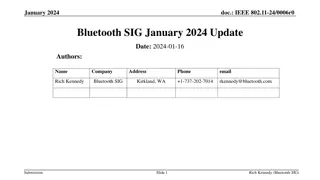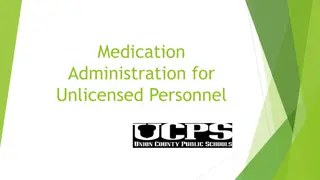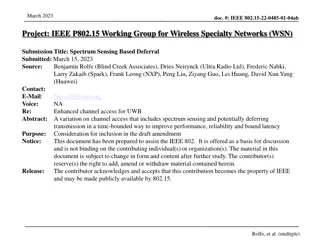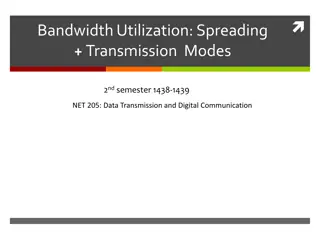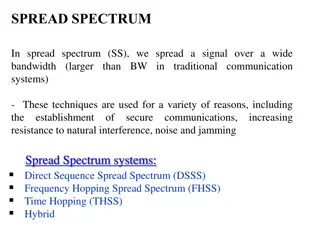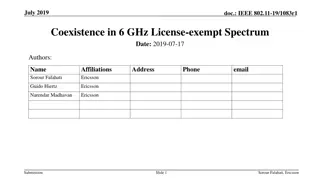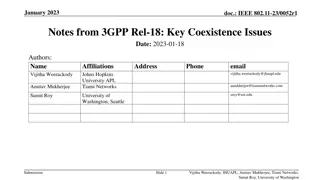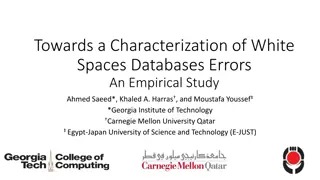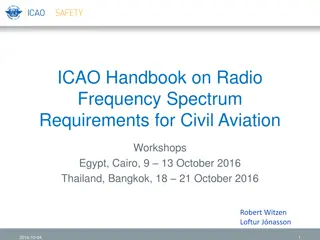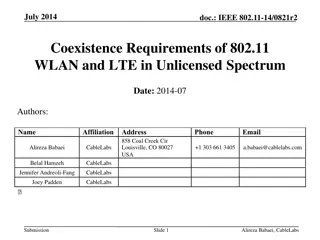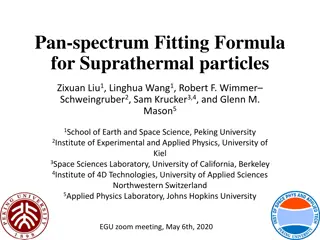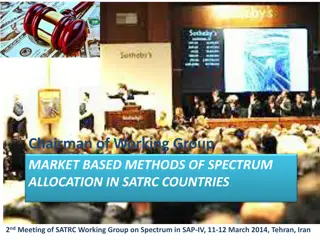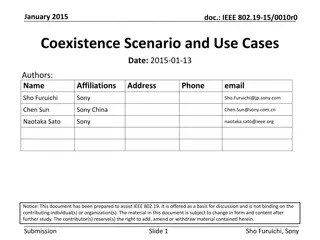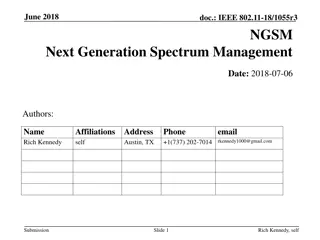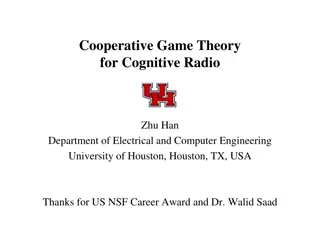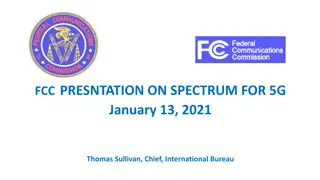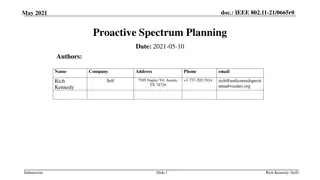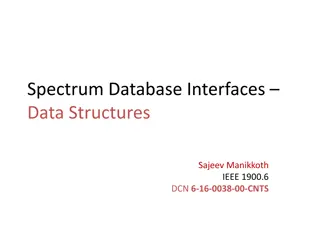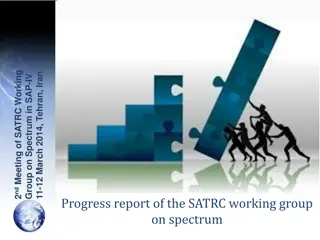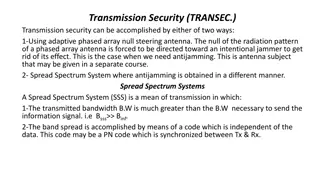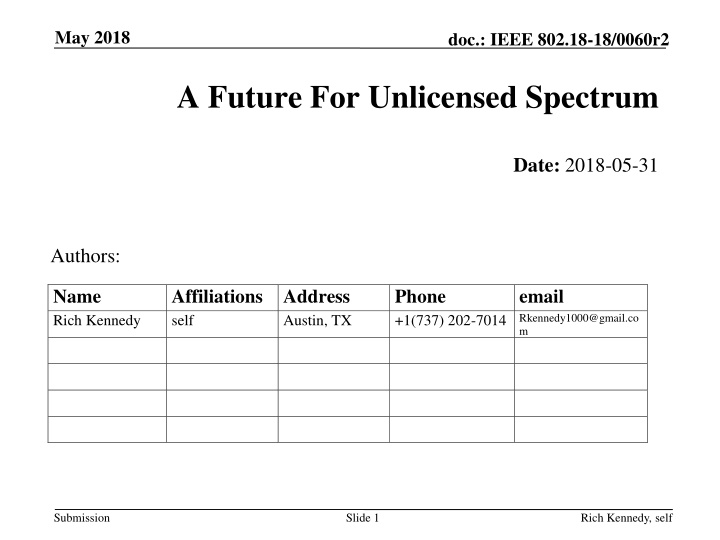
Advancing Wireless Technologies through Unlicensed Spectrum Exploration
Explore the potential of unlicensed spectrum for future wireless technologies as discussed in IEEE 802.18-18/0060r2 document. Discover the challenges and opportunities in utilizing White Spaces for improved connectivity. Learn about regulatory aspects and technological breakthroughs driving the evolution of spectrum utilization.
Download Presentation

Please find below an Image/Link to download the presentation.
The content on the website is provided AS IS for your information and personal use only. It may not be sold, licensed, or shared on other websites without obtaining consent from the author. If you encounter any issues during the download, it is possible that the publisher has removed the file from their server.
You are allowed to download the files provided on this website for personal or commercial use, subject to the condition that they are used lawfully. All files are the property of their respective owners.
The content on the website is provided AS IS for your information and personal use only. It may not be sold, licensed, or shared on other websites without obtaining consent from the author.
E N D
Presentation Transcript
May 2018 doc.: IEEE 802.18-18/0060r2 A Future For Unlicensed Spectrum Date: 2018-05-31 Authors: Name Rich Kennedy Affiliations Address self Phone +1(737) 202-7014 Rkennedy1000@gmail.co email Austin, TX m Submission Slide 1 Rich Kennedy, self
May 2018 doc.: IEEE 802.18-18/0060r2 Introduction Regardless of everything we do to develop new, better, faster wireless technologies, the available spectrum has a hard limit We can continue to go higher in frequency, but there are shortcomings in range, power requirements and cost Technology breakthroughs are always possible, but infrequent Where is the better answer: Unused and underused spectrum Regulator recognition of this is key All references to unlicensed, which is an FCC term, also refers to license exempt, as used elsewhere Whitepaper with additional information https://www.dropbox.com/s/g950142cqlghh3d/Multiband%20White%20Space%20 Spectrum%20Access%20.pdf?dl=0 Submission Agenda Slide 2 Rich Kennedy, self
May 2018 doc.: IEEE 802.18-18/0060r2 White Spaces DARPA Project XG tried to take advantage of unused spectrum www.daml.org/meetings/2005/04/pi/DARPA_XG.pdf Sensing across a range of frequencies could locate unused segments for a specific location and time, i.e. White Spaces Perfect identification of unused spectrum required, and very difficult using only sensing In 2006, the FCC looked at this WRT the TV bands The digital transition could make a lot of spectrum available for unlicensed use However, the decision to auction the 600 MHz band severely limited the number of available channels Submission Slide 3 Rich Kennedy, self
May 2018 doc.: IEEE 802.18-18/0060r2 TV White Spaces To take advantage of this FCC offer , IEEE 802 developed two new standards 802.11af for Local Area Networks (WLAN) 802.22 for Regional Area Networks (WRAN) The key to the success of this consumer technology was low cost based on Wi-Fi economies of scale as semiconductor companies could count on large markets Unfortunately, with places like New York, Los Angeles and Chicago with one or fewer TVWS channels available, interest in developing silicon waned TVWS R.I.P. (at least foe WLANs) Submission Slide 4 Rich Kennedy, self
May 2018 doc.: IEEE 802.18-18/0060r2 Rethinking White Spaces The limited expectations for TVWS resulted in a loss of interest in all White Spaces Based on location and time, there are still vast amounts of White Space, but with technical challenges Meeting technical and regulatory challenges has always been an IEEE 802 focus The key to rethinking White Spaces is identifying the challenges and meeting them So what are the challenges? Technical: Efficient operation across a wide range of frequencies Regulatory: Getting help from regulators to enable use of all White Spaces Submission Slide 5 Rich Kennedy, self
May 2018 doc.: IEEE 802.18-18/0060r2 Addressing the Technical Challenges Today s low cost technologies cannot efficiently address a wide range of frequencies Radio components such as PAs, LNAs, and antennas are optimized for relatively narrow frequency ranges Different frequency bands can have different regulatory limits on bandwidth, power, etc. Breaking the radio out into a separate module can support multiple bands with today s technologies Immediately applicable for last-mile wireless Technology advances can address WLAN with Wi-Fi- like economies of scale Submission Slide 6 Rich Kennedy, self
May 2018 doc.: IEEE 802.18-18/0060r2 Basic Architecture & Application Antenna x Basic MAC Module [1] Radio Module x [2] LNAx [5] RADIOx [4] Medium Access Control PAx [6] I/O ISM Radio [9] Regulatory control [3] MEMORYx [7] Internet Regulatory Database [8] MAC Module Radio Module x Radio Module x MAC Module xWS Radio (STA) xWS Radio (AP) Remote Central Submission Slide 7 Rich Kennedy, self
May 2018 doc.: IEEE 802.18-18/0060r2 Radio Module Features Band specific radio, PA, LNA and antenna Bandwidth selected for efficiency/cost of RF components Selectable efficiency For cost reduction wider bandwidth coverage with a single module at lower efficiency Memory device with regulatory database information relative to the specific band Pre-programmed Internet updateable Contains MAC parameters for the specific band Communicates with MAC module MAC setup Periodic regulatory updates from the Internet Checks for energy on white space channels and reports to central database Optional additional radio for In-Service Monitoring (ISM) Submission Slide 8 Rich Kennedy, self
May 2018 doc.: IEEE 802.18-18/0060r2 MAC Module Features Standard 802.11 or 802.22 MAC Regulatory controls Interface with Radio module to get MAC parameters for the specific band to provide updates to database memory Interface with the database via the Internet to get database updates to relay detected database errors, inaccuracies Submission Slide 9 Rich Kennedy, self
May 2018 doc.: IEEE 802.18-18/0060r2 Much Work Needed Only the basic concepts are addressed here Separation of the radio module will require standards work To make this workable for low-cost WLAN use, advances are needed Frequency adjustable antennas need to be made practical for this application Wide-range, efficient approach to LNA, PA design I suggest we develop a position paper on why IEEE 802 believes that database control of spectrum access is a future requirement, and regulators need to start that development now Slide 10 Submission Rich Kennedy, self
May 2018 doc.: IEEE 802.18-18/0060r2 Addressing the Regulatory Challenges Far more daunting are the regulatory challenges Regulators hesitant to upset the status quo, i.e. fixed allocation of spectrum with traditional protections against interference Incumbents resist any sharing, no matter how effective technology is in protecting them from interference Incumbents who have paid for spectrum do not want to deal with freeloaders TVWS database proven effective CBRS database being tested; 6 GHz band sharing will need a database AI can significantly add to protection of incumbents and effective sharing Slide 11 Submission Rich Kennedy, self
May 2018 doc.: IEEE 802.18-18/0060r2 What We Must Do Convince regulators that unlicensed spectrum is important, and this is the only way it can continue to support wireless applications Show the importance of unlicensed spectrum Benefit to the economy Benefits to education A means to get everyone connected to the Internet, in an economical way Develop a plan of action on engaging AI in spectrum management, and show the benefits We must start NOW! Submission Slide 12 Rich Kennedy, self
May 2018 doc.: IEEE 802.18-18/0060r2 Questions? Submission Slide 13 Rich Kennedy, self


